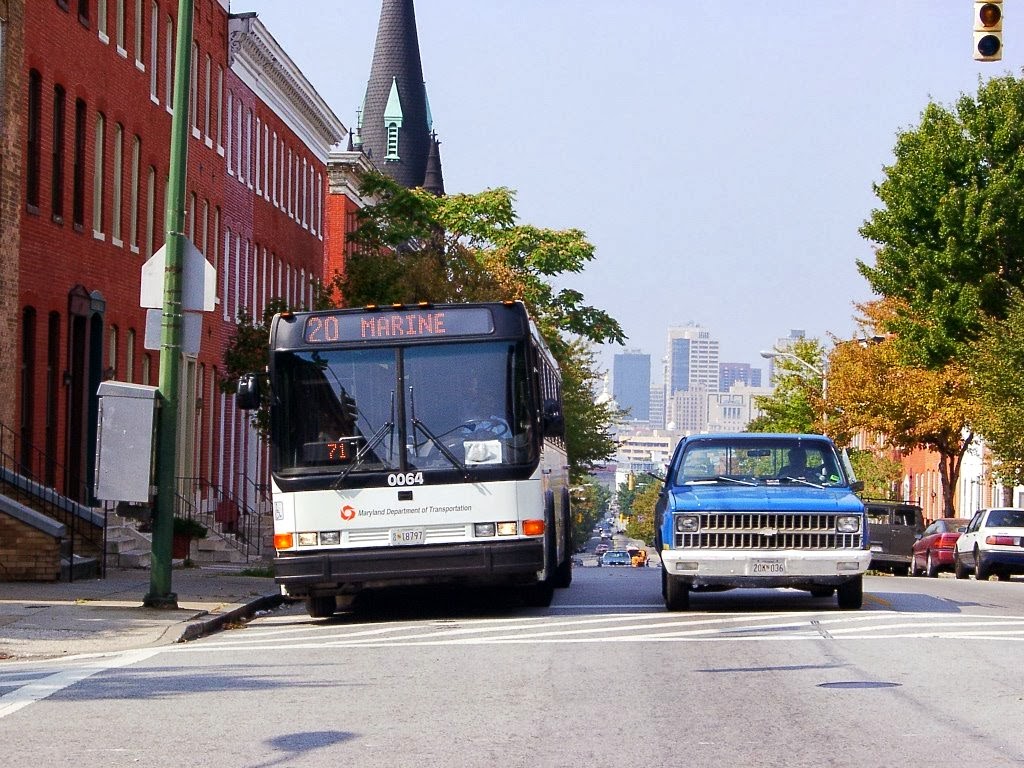No, this is not referring to what a dog or frat boy does to the newly fallen snow. It is actually one of the more instantly rewarding methods used in transit photography to create a very memorable image. Quite simply, it is the deliberate placement of a landmark of some sort into the framing of the image.
Though it normally requires some degree of pre-planning to best accomplish, it is among the best ways to add local context and story to your transit images. Even more interestingly, it can be accomplished in numerous ways compositionally. Let's take a look at some composition methods with landmarks.
Distant:
With this method, the landmark of interest is typically at least a half a mile away in the backdrop. This method is often used to bring skylines or other massive structures into the frame. Though a zoom lens can be helpful in compressing the composition and make the distant landmark more prominent, it may not always be necessary. The photo above was simply taken at a normal focal length.
Nearby:
This composition method works well with landmarks of moderate size and/or height and involves a setup anywhere from a block away to as much as a half a mile, depending partially on sight lines, but also shaped largely by the focal length of the shot. A wide angle shot and a partial telephoto shot will have significant compositional differences on the background elements.
Adjacent:
This composition method works well with more modest size landmarks and involves taking an image of the transit vehicle passing directly by the landmark itself. It works well with items like fountains and statues, as seen above, but also with modest size urban movie theaters, diners, or potentially even recognizable natural features such as a community Christmas tree.
Foreground:
Though not too often used, this can actually be one of the more engaging and fun ways to compose photos with a transit context. In these images, the transit vehicle becomes much more of an incidental in the photograph, as opposed to a cornerstone, but with some creative composition, it doesn't have to be relegated to being unimportant. This composition method is typically only workable with smaller landmarks such as sidewalk statuary and monuments.
Combining Landmarking methods:
When working landmarks into your transit images, there is certainly no rule that states that you need to only use a single composition method. In fact, your photo can tell a great deal more by combining multiple methods onto a single image. The photo above is one of my favorite examples of this, positioning the Baltimore skyline as a distant landmark with the Patterson Theater in a nearby/adjacent position. The result is an image that offers a significant amount of geographic context.
Putting these methods into practice:
Landmarking can also be a pretty fun thing to plan for, and this planning can be done in a couple of ways, depending on one's familiarity with the region they are planning to photograph. One might take the timetable map of a line and work their way along it trying to figure out good places to work in landmark type shots. One can also think specifically of the landmark that they want to work into their shot, and then work outward to research transit lines that can be readily incorporated into the shot.
In either method, it can also be helpful to consider lighting factors that may be at play as well as traffic conditions that might hinder one's ability to get the desired photo. Recent tools such as Google Maps and their Streetview Tool can also be quite helpful in doing some homework to offer good starting locations for setting up shop. However, do keep in mind that Streetview uses a very wide angle lens, which can distort the relation of distant objects. For example, the location in the photo just above looks like this in GSV, leaving one to believe the distant skyline is not even visible.
View Larger Map
One of the more rewarding things about landmarking is that the frustration factor can be lessened with proper planning and a bit of good luck. In nearly all cases, landmarks don't move, so they can pre-composed as you await the one mobile item to complete the composition, the transit vehicle. Now to only hope another mobile item that you don't want to be prominent in your composition doesn't come along and wreck things!







No comments:
Post a Comment